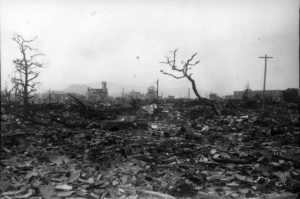Documenting Hiroshima of 1945: August 20, house in Sorazaya-cho vanished without trace
Aug. 20, 2024
by Minami Yamashita, Staff Writer
On August 20, 1945, two weeks after the atomic bombing, debris was scattered all around Sorazaya-cho (in Hiroshima’s present-day Naka Ward), an area previously packed with local factories and wooden houses. Masami Ogi, who worked at the Kure Naval Arsenal in Kure City during the war and died in 2007 at the age of 93, took a photo of the area, located around 700 meters to the northwest of the hypocenter.
“Everything was gone,” said Keiko Morioka, 88, a resident of Hiroshima’s Naka Ward who was nine at the time of the bombing. On August 17, three days before Mr. Ogi took the photo, Ms. Morimoto and her mother entered the area, where they had lived before being evacuated outside the city in April. No trace remained of the home where Ms. Morioka had been born and raised. Plates that her mother had carefully buried in the ground were melted by the bombing’s extreme heat. She explained, “The air temperature was high there, and the ground was hot, too.” They satisfied their thirst with water gushing from a burst water pipe.
The Sorasayainao Shrine, located next to their home, had also been burned to the ground, with only the shrine’s torii gate and stone guardian lion-dogs remaining. Before the atomic bombing, local children would play on the shrine’s grounds and people would visit to offer prayers when getting into Honkawa National School (present-day Honkawa Elementary School). It served as a place of comfort for people in the local area.
Ms. Morioka said, “To this day, I refuse to go in the direction of Sorazaya-cho because my heart still aches.” The entire family of her best friend, who lived in the neighborhood, and an uncle of hers who lived in Takajo-machi, a district located next to Sorazaya-cho, were killed in the atomic bombing.
According to the Record of the Hiroshima A-bomb War Disaster, which was published in 1971, the personal suffering in Sorazaya-cho at the time of the bombing included nearly 90 percent of the people in the area “dying immediately.” After entering Hiroshima and returning to her evacuation home, Ms. Morioka was bedridden for one week due to ill health marked by headaches and nausea.
(Originally published on August 20, 2024)
On August 20, 1945, two weeks after the atomic bombing, debris was scattered all around Sorazaya-cho (in Hiroshima’s present-day Naka Ward), an area previously packed with local factories and wooden houses. Masami Ogi, who worked at the Kure Naval Arsenal in Kure City during the war and died in 2007 at the age of 93, took a photo of the area, located around 700 meters to the northwest of the hypocenter.
“Everything was gone,” said Keiko Morioka, 88, a resident of Hiroshima’s Naka Ward who was nine at the time of the bombing. On August 17, three days before Mr. Ogi took the photo, Ms. Morimoto and her mother entered the area, where they had lived before being evacuated outside the city in April. No trace remained of the home where Ms. Morioka had been born and raised. Plates that her mother had carefully buried in the ground were melted by the bombing’s extreme heat. She explained, “The air temperature was high there, and the ground was hot, too.” They satisfied their thirst with water gushing from a burst water pipe.
The Sorasayainao Shrine, located next to their home, had also been burned to the ground, with only the shrine’s torii gate and stone guardian lion-dogs remaining. Before the atomic bombing, local children would play on the shrine’s grounds and people would visit to offer prayers when getting into Honkawa National School (present-day Honkawa Elementary School). It served as a place of comfort for people in the local area.
Ms. Morioka said, “To this day, I refuse to go in the direction of Sorazaya-cho because my heart still aches.” The entire family of her best friend, who lived in the neighborhood, and an uncle of hers who lived in Takajo-machi, a district located next to Sorazaya-cho, were killed in the atomic bombing.
According to the Record of the Hiroshima A-bomb War Disaster, which was published in 1971, the personal suffering in Sorazaya-cho at the time of the bombing included nearly 90 percent of the people in the area “dying immediately.” After entering Hiroshima and returning to her evacuation home, Ms. Morioka was bedridden for one week due to ill health marked by headaches and nausea.
(Originally published on August 20, 2024)








